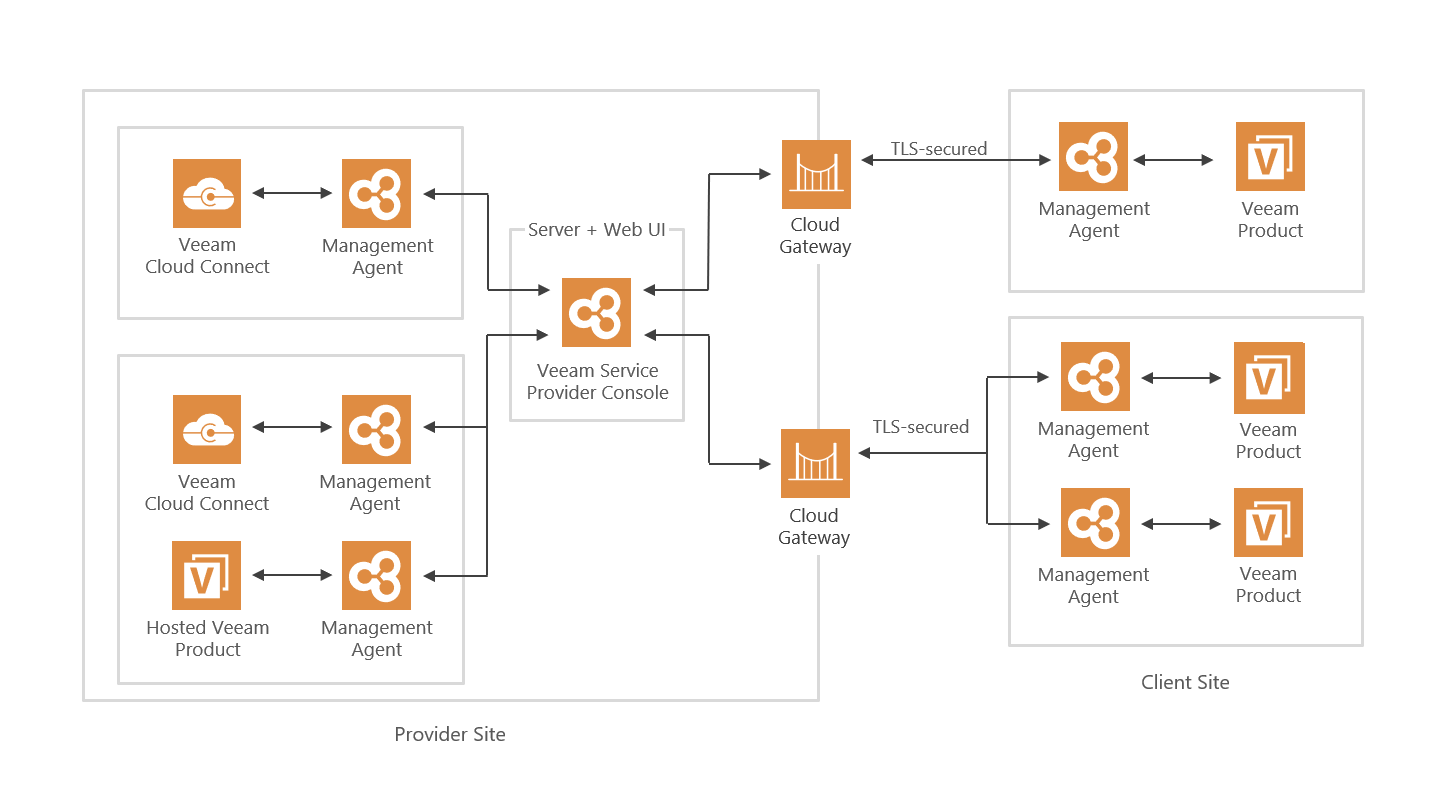Architecture in Brief
Veeam Service Provider Console is a cloud-based solution with a distributed architecture. The product architecture comprises the following structural components:
- Veeam Service Provider Console portal
- Cloud infrastructure components
- Management agents
Veeam Service Provider Console Portal
The core component of the solution architecture is Veeam Service Provider Console. Veeam Service Provider Console is a multitenant web-based portal for centralized management and monitoring of backup operations and services.
Veeam Service Provider Console includes two structural parts — Veeam Service Provider Console Server and Veeam Service Provider Console Web UI. Veeam Service Provider Console Server is the engine responsible for providing centralized management of Veeam backup agents and Veeam Backup & Replication. Veeam Service Provider Console Web UI provides a web interface that allows users to interact with Veeam Service Provider Console Server.
Cloud Infrastructure
Veeam Service Provider Console allows you to manage Veeam products installed on machines in local or remote networks. To communicate with managed machines, Veeam Service Provider Console utilizes a cloud infrastructure implemented with Veeam Cloud Connect.
The major components of the cloud infrastructure are cloud gateways and the Veeam Cloud Connect server. Cloud gateways build a bridge between the Veeam Service Provider Console portal on one side and managed machines on the other side, and implement a TLS-secured communication tunnel between these two sides.
The Veeam Cloud Connect server is responsible for managing cloud infrastructure components. Additionally, if you use Veeam Cloud Connect to provide cloud repository and cloud host resources to clients or enterprise business units, the Veeam Cloud Connect server is responsible for managing these resources.
To interact with machines in managed infrastructures, Veeam Service Provider Console uses management agents. Management agents are Veeam Service Provider Console software components responsible for collecting data and performing all types of management, software installation and configuration tasks on managed machines. Management agents must be installed on machines that run Veeam products (Veeam backup agents, Veeam Backup & Replication, Veeam Cloud Connect, Veeam ONE and Veeam Backup for Microsoft 365 servers). You can also install management agents on Veeam Backup Enterprise Manager.
A Veeam Service Provider Console management agent can act as a cloud agent, client agent, master agent or infrastructure agent.
- Cloud management agent is used to interact with Veeam Cloud Connect servers in the service provider infrastructure.
- Client management agent is used to interact with Veeam products installed on client computers.
- Master management agent is used to perform discovery of computers in the client infrastructure, and automate installation and update of Veeam backup agents.
- Infrastructure management agent is used to interact with Veeam products hosted in the service provider infrastructure.
Communication Between Components
Communication between management agents and Veeam Service Provider Console is performed as follows:
Veeam Service Provider Console management agent setup file contains the list of FQDN or IP addresses of cloud gateways assigned to the company. This list can include only up to 7 IP addresses or 150 FQDN symbols. When you deploy a management agent on a computer, the agent connects to Veeam Service Provider Console using the first available gateway from the list. If the connection fails, the management agent will automatically fail over to the next gateway. Once the connection is established, the management agent obtains from Veeam Service Provider Console FQDN or IP addresses of all cloud gateways assigned to the company.
Management agents deployed on machines that run client Veeam products (Veeam backup agents, Veeam Backup & Replication, Veeam ONE and Veeam Backup for Microsoft 365) collect data about the managed software, and send this data to cloud gateways. Cloud gateways, in their turn, communicate obtained data to Veeam Service Provider Console. Management agents deployed on Veeam Cloud Connect servers and on machines that run hosted Veeam products send data to Veeam Service Provider Console directly, bypassing cloud gateways. Commands from Veeam Service Provider Console to management agents are communicated in the reverse order, by the same path.
Veeam Service Provider Console stores collected data to the Veeam Service Provider Console database, and makes it available in the Veeam Service Provider Console portal. The database can be hosted on a Microsoft SQL Server that runs on the same machine where Veeam Service Provider Console is installed, or on a remote Microsoft SQL Server (recommended).